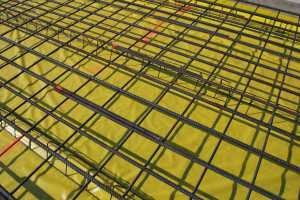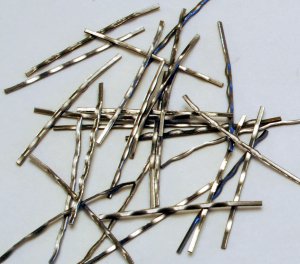Steel Fibers & Rebar
Steel fibers and rebar have some things in common. Both are made of steel. Both are used to reinforce concrete, and both can be found in floor slabs. Because of those common features, it is tempting to think of the two products as fundamentally alike, differing only in size. Maybe a steel fiber is just a very small reinforcing bar. Some of our competitors encourage this line of thinking. One maker of steel fibers even calls its product “Micro-Rebar” and claims it “is a replacement for rebar.”
But that’s wrong. Steel fibers and rebar work differently and accomplish different goals. Sometimes you need steel fibers, and sometimes you need rebar, and only in a few limited situations can one effectively replace the other.
To put it simply, steel fibers prevent cracks, while rebar limits the width of cracks. Let’s consider two examples: a wide-slab floor and a continuously-reinforced concrete highway.
Example 1 (photo below) is a warehouse floor 250 feet wide and 500 feet long. Following CFS Wide-slab principles, the concrete contains steel fibers at 70 pcy. The floor is divided into eight slabs, each 125 feet by 125 feet. Slabs are laid over a plastic slipsheet and are carefully isolated from building columns and walls. Thanks to the steel fibers, each of those eight slabs is free of internal joints and cracks. You can’t do that with rebar.
Example 2 is a concrete highway two miles long. Following CRCP (continuously-reinforced concrete pavement) principles, the concrete contains longitudinal rebar equal to 0.7% of the slab’s cross-sectional area, and there are no transverse joints within the two-mile length. Bar ends are carefully staggered and lapped according to the Federal Highway Administration’s Technical Advisory T 5080.14. The highway develops several thousand transverse cracks, but thanks to the continuous rebar the cracks all stay tight. You can’t do that with steel fibers.
Example 1: Wide Slab floor made with steel fibers at 67 pcy and joints 100 to 125 feet apart. The floor is free of visible cracks. Rebar could not have achieved this result.
Example 2: Heavy continuous rebar in a long-strip floor slab. With bar ends lapped, rebar can provide continuity over any length. Steel fibers can’t do that.
How Steel Fibers Prevent Cracks
Let’s start with some definitions. For our purposes here, a crack is a break big enough to see with the naked eye. Cracks often penetrate a slab from top to bottom, and may extend all the way across a slab’s width. A microcrack is a break visible only with a microscope. Microcracks typically do not go all the way through a slab, nor all the way across its width.
All concrete has microcracks, and some of them appear at an early age. When concrete is subject to tensile stress, which can come from drying shrinkage, thermal contraction, or applied loading, some microcracks grow wider and longer and become cracks you can see. Not every microcrack grows up to be a crack; most of them stay small. However, every crack started life as a microcrack.
Neither steel fibers nor rebar can eliminate microcracks. But any piece of imbedded steel, in the right place, has the potential to stop a microcrack in its tracks. This is true of steel fibers, rebar, or even wire mesh.
But here’s the trick. The imbedded steel has to be very close to the source of the microcrack to stop its growth. Once a crack has developed enough momentum, nothing can stop it from ripping all the way across a slab. This is where steel fibers prove their worth, because only fibers can provide the dense distribution of steel needed to catch every microcrack (Photo 3). If you make concrete with CFS 100-2 steel fibers at 70 pcy (pounds per cubic yard), you get, on average, 12 fibers in each cubic inch of concrete. No microcrack can go more than a fraction of an inch without running into a fiber. In contrast, rebar designs always space the bars several inches apart, giving microcracks plenty of room in which to grow.
If you make concrete with CFS 100-2 steel fibers at 70 pcy (pounds per cubic yard), you get, on average, 12 fibers in each cubic inch of concrete. No microcrack can go more than a fraction of an inch without running into a fiber. In contrast, rebar designs always space the bars several inches apart, giving microcracks plenty of room in which to grow.
Example 3: Only steel fibers can provide the dense distribution of steel needed to stop microcracks from growing.
The Role of Rebar
Since steel fibers do such a good job preventing cracks, why would we ever reinforce concrete with anything else? Well, it turns out that fibers can’t prevent every crack in every situation. With enough tensile stress driving it, a crack can rip past the fibers and grow wide. Often you can design concrete structures so the tensile stresses stay low, and then steel fibers do fine as the sole reinforcement. That’s the idea behind wide-slab floors (Photo 1 above), which are made thick enough to resist applied loads without cracking, and which incorporate stress-relief joints no more than 125 feet apart. But sometimes you have to design for high tensile stresses, and that’s when rebar comes into its own.
The value of rebar lies in its ability to resist tensile stress after concrete has cracked, and also in its length, which allows for continuity over long distances. The longest steel fibers are about 2-1/4 inches long, and the fibers best suited to preventing cracks are shorter than that. In contrast, rebar comes in 40-foot and 60-foot lengths, and with the right laps (Photo 2) it can be extended without limit. Only rebar can provide continuous reinforcement over the full span of a suspended slab or beam. Only rebar can run the whole length of a continuously-reinforced concrete highway.
No Equivalence
Engineers wishing to switch a design from rebar to steel fibers sometimes use formulas or tables to determine the fiber dosage. One table available on the internet bears the title: “Pounds of 1.0″ steel fibers per cubic yard of concrete to match the cross sectional area of steel for continuous reinforcing”. While such formulas and tables may be mathematically correct and can be useful, they lead to a fallacy: the idea that steel fibers and rebar are equivalent and that one can readily substitute for the other.
In truth, steel fibers and rebar can never be equivalent because they work differently and achieve different goals. If a design really needs one, no amount of the other will accomplish the same result.
Steel Fibers and Rebar Together
Since steel fibers and rebar achieve different goals, it often makes good sense to use both. V. Paulius and Associates, a developer, designer, and builder, recently completed a freezer floor in Carteret, New Jersey, that combined steel fibers and rebar with good results.
The floor slab, 9-inches thick, was designed to support a very-narrow-aisle rack system with wire-guided turret trucks. The turret-truck maker called for a near-superflat, Fmin75 surface. To meet that specification, the floor was divided into long, narrow strips with an aisle centered on each strip. The typical strip was about 15 feet wide and 344 feet long (Photo 4).
Example 4: Long-strip, high-tolerance floor by V. Paulius and Associates in Carteret, New Jersey. This slab is 15 feet wide and 344 feet long, with no transverse joints. It was reinforced with both steel fibers and rebar.
After considering several options, including an all-rebar design and a design using plastic fibers, Paulius chose to use both rebar and steel fibers. Each strip was reinforced in the long direction with #5 bars spaced 8-1/2 inches on center, providing steel equal to 0.4% of the slab’s cross-sectional area. In addition, CFS 100-2 steel fibers were added to the concrete at a dosage of 35 pcy, equal to 0.26% of the concrete’s volume. There were no transverse joints. The slabs rested on insulation boards, with a 6-mil polyethylene slipsheet between insulation and concrete.
The results were impressive. Some transverse cracks appeared, but they were few and they stayed narrow (Photo 5), despite the 344-foot slab length. It seems likely that both the steel fibers and the rebar contributed to this floor’s success. The steel fibers reduced the number of cracks, while the rebar limited the width of the few cracks that occurred.
Next time someone asks “steel fibers or rebar?” remember that it’s not really a choice. If you want to stop microcracks from growing into visible cracks, you need steel fibers. If you want to limit the width of cracks that will occur anyway, you need rebar. And if you want to achieve both goals, maybe you need both products.
Example 5: Typical hairline crack in the Carteret floor. The pencil lead is 0.028 inch wide.





